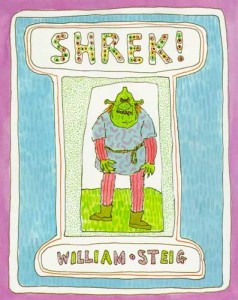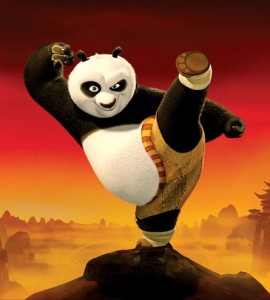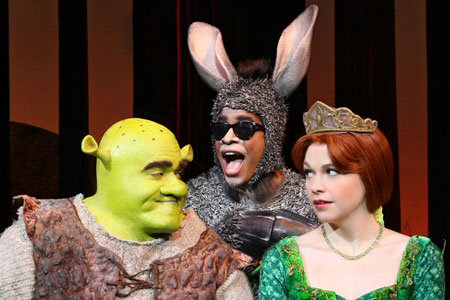How “Shrek” Changed Animation Happily Ever After
 Today marks the release of “Shrek: The Whole Story.” No, no, this is not a new “Shrek” film, thank goodness — the last film came out in May, it’s over (unless you count the upcoming “Puss in Boots” spinoff). Anyway, today you can buy all four chapters together in a box set — just in time for Christmas — and celebrate Shrek’s legacy.
Today marks the release of “Shrek: The Whole Story.” No, no, this is not a new “Shrek” film, thank goodness — the last film came out in May, it’s over (unless you count the upcoming “Puss in Boots” spinoff). Anyway, today you can buy all four chapters together in a box set — just in time for Christmas — and celebrate Shrek’s legacy.
And what a legacy. After four films spanning ten years and more than $3 billion in theater receipts worldwide, saying everyone’s favorite green ogre impacted the industry massively understates it.
Where to even begin? How about the franchise’s production company, DreamWorks, which began in 1994 with three media powerhouses in David Geffen, Jeffrey Katzenberg and Steven Spielberg and has since become almost on par with Disney as far as family entertainment goes. The studio’s first offerings were live-action animal flicks “Mousehunt” and “Paulie,” which rode the wave of live-animal family films spurred on by movies such as “Homeward Bound,” but DreamWorks really wanted in on the animated marketed dominated for so long by Disney.
Seeing as traditional animation was still booming in the mid-’90s thanks to the Mouse House, DreamWorks greenlit what would years later become traditional animated musicals: “The Prince of Egypt” (1998) and “The Road to El Dorado” (2000), but after Disney/Pixar’s “Toy Story” blew everyone away in 1995, the direction of the family limb of DreamWorks changed instantly. In competition with Pixar’s next adventure, “A Bug’s Life,” the studio released its first full-length animated film, “Antz.” The film made a tame $171 million worldwide compared to $363 million for “A Bug’s Life.” But that would soon change as the company would make DreamWorks Animation its own entity and put “Shrek” into production.
I don’t think author/illustrator William Steig envisioned his little book Shrek!, the upside-down story of an ogre who finds the ogre princess of his dreams, would become a worldwide phenomenon, but DreamWorks saw it as the perfect opportunity to flip the world of fairy tales — so long the dominant form of children’s entertainment — completely on its head.
 Herein, I believe, lies the key to the success of “Shrek” and its three sequels. Certainly there’s the character dynamic: Shrek (Mike Myers), Donkey (Eddie Murphy), Fiona (Cameron Diaz) and Puss in Boots (Antonio Banderas) have a strong comic chemistry as well as provide endless merchandising opportunities. But “Shrek” brought in $42 million when it debuted in May 2001, which stood only behind “Toy Story 2” at the time on the list of biggest animated opening weekends. Now that’s the sign of an appealing concept considering a barely known picture book was the basis for the film.
Herein, I believe, lies the key to the success of “Shrek” and its three sequels. Certainly there’s the character dynamic: Shrek (Mike Myers), Donkey (Eddie Murphy), Fiona (Cameron Diaz) and Puss in Boots (Antonio Banderas) have a strong comic chemistry as well as provide endless merchandising opportunities. But “Shrek” brought in $42 million when it debuted in May 2001, which stood only behind “Toy Story 2” at the time on the list of biggest animated opening weekends. Now that’s the sign of an appealing concept considering a barely known picture book was the basis for the film.
Someone at DreamWorks realized that while Disney made a fortune off classic characters, they didn’t own the rights to these fairy tales and the company could effectively de-glamorize and satirize the genre (and Disney) with this film, giving a breath of fresh and hysterical air to family films that had for so long been filled with goody-two shoes musicals. How to actually implement it? Hire people who have worked for Disney, of course. Ted Elliot and Terry Rossio, who had worked on “Aladdin,” co-wrote the script with a writer for “Beavis and Butthead” and one from the 1995 little-known animated film “Balto.” The duo would later draft up another billion-dollar franchise in “Pirates of the Caribbean.”
“Shrek,” in effect, bridged the traditional take on animated films to what later became the explosion of non-musical computer animation. The draw for audiences was to see honored characters and classics turned into wise-cracks. Many of the best comedies of all time have found success by playing off and twisting that with which audiences are already very familiar. Shrek the ogre is a brilliant protagonist as he’s completely the opposite of everything a protagonist is supposed to be, angry at the world of fairy tale goodness and spiteful of his strange companions.
The film (and especially its sequel, “Shrek 2”) was also incredibly inappropriate. Disney had been known for adding in humor and easter eggs that would whiz over kids’ heads and please adults, but “Shrek” took this to another level. The line was most definitely crossed, but kids remained oblivious while their folks were overjoyed to be that entertained by something their kids just loved because “Donkey was silly.” True, the real glue was the writing of these memorable characters who were as refreshing as the concept.
When “Shrek” hit with audiences, DreamWorks probably could not move faster to whip up a sequel. Two more traditional animated films had already been moving forward pre-“Shrek,” but by 2001, it was painfully obvious that classic style was dying. The company had to brace for the financial blows it would incur the next year from “Spirit: Stallion of the Cimarron” (2002) and the next year from “Sinbad: Legend of the Seven Seas” (2003). The latter opened with fewer than $6 million on July 4th weekend and finished with just above $80 million worldwide. Even after “Shrek 2” obliterated animated opening weekend records with $108 million in 2004, the company was still saddled with debt. In 2005, they were purchased by Viacom and films were distributed through the company’s major motion picture arm, Paramount Pictures.
But DreamWorks didn’t stay dependent for long. Projects that had begun after the 2001 success of “Shrek” (in addition to the sequel) were paying dividends. That was “Shark Tale” (2004) and “Madagascar” (2005). Although neither did the gross business of “Shrek,” both did about $47 million in business when they opened, which was a strong enough supplement to the live action films making money for them at the time like “Meet the Fockers” and “War of the Worlds.” Eventually, starting in 2007 and finalizing in 2008, the studio became independent of Paramount with backing from an Indian investment firm. Paramount, however, still owns distribution rights through 2012.
Obviously, the story got better for DreamWorks, though it was clear the “Shrek” mega-franchise was running out of steam. “Shrek the Third” broke the animated weekend opening record again for the franchise though it made less on the whole. “Shrek Forever After” saw a significant drop in business on both ends, but by then everyone knew it was a last-ditch effort to make some money.
 Certainly the financial peril of DreamWorks catapulting the “Shrek” sequels to the fast track hurt the quality of the films. Whereas Disney could afford to take time with sequels and make them amazing (see “Toy Story 3”) and greenlight provocative originals year in and year out, DreamWorks couldn’t afford it, simply put, even though three years lapsed between films. As much as we could yell at them for sucking the creativity out of and over-merchandizing the green ogre to death, they had no other staples — yet. “Madagascar” would emerge with franchise potential, but not until “Kung Fu Panda” in 2008 did a potential fat and stubborn successor emerge to our fat and stubborn ogre. That sequel hits in May. With this year’s “How to Train Your Dragon” emerging as yet another hit, the studio can breathe easy and just last week, Katzenberg already mentioned that there are ideas/plans for six total “Panda” movies, four total “Madagascar” movies and a complete “Dragon” trilogy. With three years between being the “standard,” it’s hard to envision continued quality, but surely another franchise wannabe will emerge in that time.
Certainly the financial peril of DreamWorks catapulting the “Shrek” sequels to the fast track hurt the quality of the films. Whereas Disney could afford to take time with sequels and make them amazing (see “Toy Story 3”) and greenlight provocative originals year in and year out, DreamWorks couldn’t afford it, simply put, even though three years lapsed between films. As much as we could yell at them for sucking the creativity out of and over-merchandizing the green ogre to death, they had no other staples — yet. “Madagascar” would emerge with franchise potential, but not until “Kung Fu Panda” in 2008 did a potential fat and stubborn successor emerge to our fat and stubborn ogre. That sequel hits in May. With this year’s “How to Train Your Dragon” emerging as yet another hit, the studio can breathe easy and just last week, Katzenberg already mentioned that there are ideas/plans for six total “Panda” movies, four total “Madagascar” movies and a complete “Dragon” trilogy. With three years between being the “standard,” it’s hard to envision continued quality, but surely another franchise wannabe will emerge in that time.
When you look at that future plan, you have “Shrek” to thank. $40 million is the expected opening for an animated film these days that has a substantial draw and good marketing. That was unfathomable 10 years ago. Soon, animated studios began popping up with major companies as backers. 20th Century Fox followed closely behind, opening their animation studio and debuting with 2002’s under-appreciated franchise-starter “Ice Age.” Warner Bros. (“Happy Feet”) and Sony (“Monster House”) followed suit in 2006, with the former winning an Oscar — its very first film. Universal (“Despicable Me”) just got started this year and Lionsgate has films in production. Oh yeah, and Disney and Pixar are both producing films en masse.
Today, we see about a dozen computer animated films per year released on a large scale. It’s bound to increase. The medium is also churning out better and better films, becoming one of the most critically praised genres — just look at Pixar over the last three or four years.
Now think about “Shrek” for a second. Crazy, right? All it took was a twist on the familiar fairy tale to change the face of animated family films forever. And you know it’s legit when they make a Broadway musical out of it — Broadway doesn’t take huge gambles. Even this past weekend, is it so surprising that the current No. 1 at the box office, Disney’s “Tangled,” twists the story of Rapunzel? Even Disney gets it now.






3 Comments
Cool article. I think it’s pretty interesting that DreamWorks was basically started so that Katzenberg could get revenge on his ousting from Disney, which he certainly did with “Shrek” as it won the first ever “Best Animated Film” Oscar over the heavily favored “Monster’s, Inc.” No fury like a spurned executive, right?
Well I wouldn’t say that’s how DreamWorks started, but as far as the animation branch? Yea, I’m guessing he wanted to prove they didn’t have a monopoly on animation.
You better listen up, that movie inspired Disney to change Reboot Ralph to Wreck-It Ralph, and its sequel is in development, so I want it cancelled right now! (I don’t want more guest appearances since Sonic and All Stars Racing Transformed, and characters from movies invading websites. In fact, Disney is now using Alan Tudyk over and over to copy Pixar, who has John Ratzenberger.)